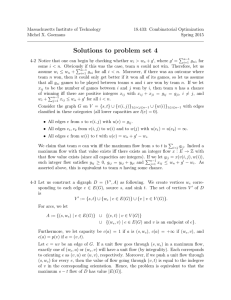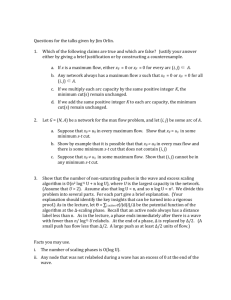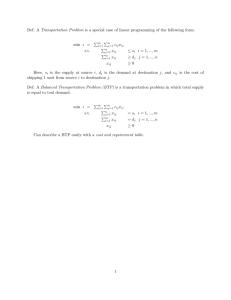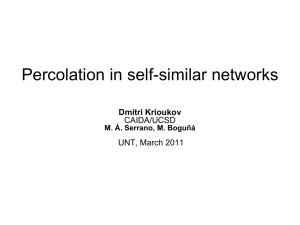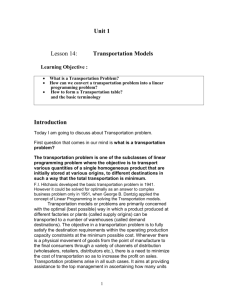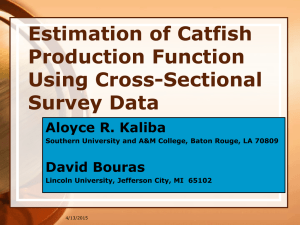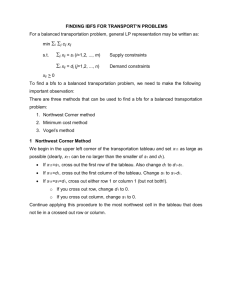Document 10951966
advertisement
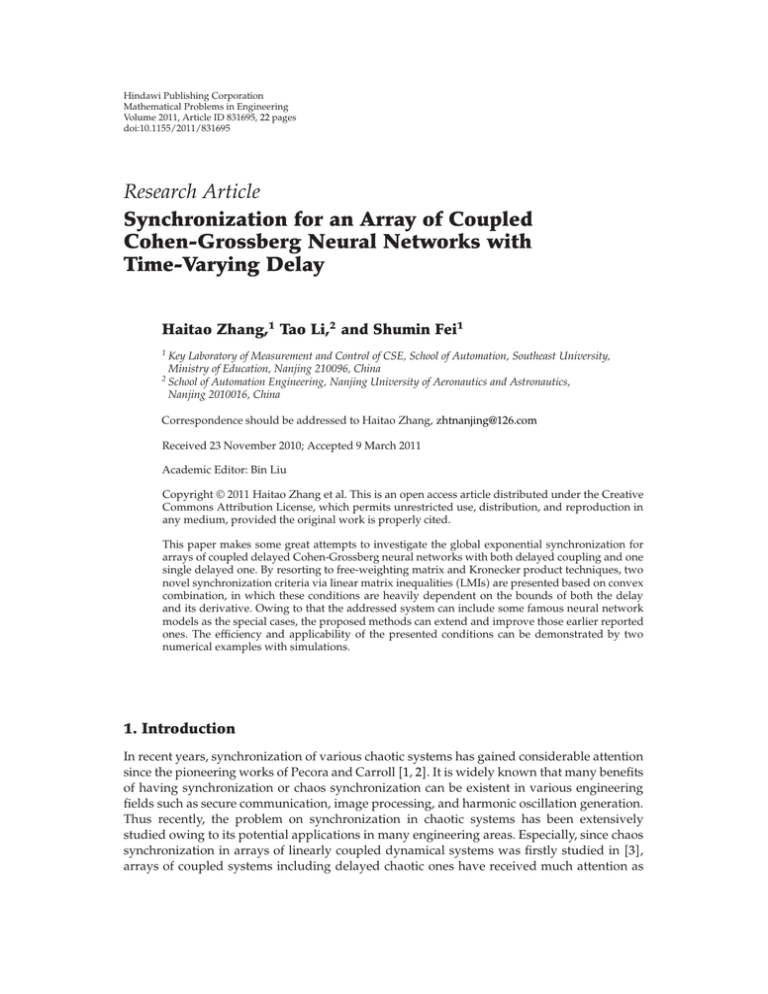
Hindawi Publishing Corporation
Mathematical Problems in Engineering
Volume 2011, Article ID 831695, 22 pages
doi:10.1155/2011/831695
Research Article
Synchronization for an Array of Coupled
Cohen-Grossberg Neural Networks with
Time-Varying Delay
Haitao Zhang,1 Tao Li,2 and Shumin Fei1
1
Key Laboratory of Measurement and Control of CSE, School of Automation, Southeast University,
Ministry of Education, Nanjing 210096, China
2
School of Automation Engineering, Nanjing University of Aeronautics and Astronautics,
Nanjing 2010016, China
Correspondence should be addressed to Haitao Zhang, zhtnanjing@126.com
Received 23 November 2010; Accepted 9 March 2011
Academic Editor: Bin Liu
Copyright q 2011 Haitao Zhang et al. This is an open access article distributed under the Creative
Commons Attribution License, which permits unrestricted use, distribution, and reproduction in
any medium, provided the original work is properly cited.
This paper makes some great attempts to investigate the global exponential synchronization for
arrays of coupled delayed Cohen-Grossberg neural networks with both delayed coupling and one
single delayed one. By resorting to free-weighting matrix and Kronecker product techniques, two
novel synchronization criteria via linear matrix inequalities LMIs are presented based on convex
combination, in which these conditions are heavily dependent on the bounds of both the delay
and its derivative. Owing to that the addressed system can include some famous neural network
models as the special cases, the proposed methods can extend and improve those earlier reported
ones. The efficiency and applicability of the presented conditions can be demonstrated by two
numerical examples with simulations.
1. Introduction
In recent years, synchronization of various chaotic systems has gained considerable attention
since the pioneering works of Pecora and Carroll 1, 2. It is widely known that many benefits
of having synchronization or chaos synchronization can be existent in various engineering
fields such as secure communication, image processing, and harmonic oscillation generation.
Thus recently, the problem on synchronization in chaotic systems has been extensively
studied owing to its potential applications in many engineering areas. Especially, since chaos
synchronization in arrays of linearly coupled dynamical systems was firstly studied in 3,
arrays of coupled systems including delayed chaotic ones have received much attention as
2
Mathematical Problems in Engineering
they can exhibit some interesting phenomena 4, 5, and a great number of elegant results
have been derived 6–28.
As a typical complex systems, delayed neural networks DNNs have been verified
to exhibit some complex and unpredictable behaviors such as stable equilibria, periodic
oscillations, bifurcation, and chaotic attractors. Thus recently, chaos synchronization for
arrays of coupled DNNs have been discussed and some elegant results have been propose
12–28. The global synchronization of linearly coupled DNNs with delayed coupling was
investigated in 12, in which the dynamical behavior of the uncoupled system could
be chaotic or others. The authors in 13 have considered the robust synchronization of
coupled DNNs under general impulsive control. In 14, this paper has proposed an adaptive
procedure to the synchronization for coupled identical Yang-Yang fuzzy DNNs based on
one simple adaptive controller. In 15, with all the parameters unknown, the authors
focused on the robust synchronization between two coupled DNNs that were linearly and
unidirectionally coupled, in which neither symmetry nor negative positive definiteness of
the coupling matrix were required. However, those above-mentioned results were presented
in terms of some complicated inequalities, which makes them uneasily checked and applied
to real ceases by the most recently developed algorithms. By employing Kronecker product
and LMI technique, the global synchronization and cluster one have been studied for DNNs
with couplings, and some easy-to-test sufficient conditions have been obtained 16–25, 28.
Yet, the system forms addressed in 16–25 seemed simple and some improved techniques
have not been utilized to reduce the conservatism, which make the above-mentioned results
inapplicable to tackle DNNs of more general forms.
The Cohen-Grossberg neural network CGNN model, first proposed by Cohen and
Grossberg in 1983 29, has recently gained particular research attention, since it is quite
general to include many famous network models as its special case and has promising
application potentials for tasks of associative memory, parallel computation, and nonlinear
optimization problems. Meanwhile, owing to complexity of CGNNs themselves, there were
few works studying the global synchronization for the coupled delayed CGNNs, except for
that some researchers have studied the slave-master synchronization for continuous CGNNs
in 26, 27 and synchronization for coupled discrete delayed CGNNs in 28. Thus, it is urgent
and challenging to establish some easy-to-check and less conservative results ensuring the
global synchronization of coupled continuous-time delayed CGNNs, which constitutes the
main focus of this presented work.
In this paper, the global exponential synchronization of N identical delayed CGNNs
with both delayed coupling and one single delayed one is considered and two novel LMIbased conditions are derived by using Kronecker product technique, which has not been
studied in the present literature. It shows that the chaos synchronization can be ensured by a
suitable design of inner coupled linking matrix and the inner delayed linking ones. Moreover,
some effective mathematical techniques are employed to reduce the conservatism. Finally, the
efficiency of the derived criteria can be illustrated by utilizing two numerical examples.
Notations. Rn denotes the n-dimensional Euclidean space, and Rn×m is the set of all
n × m real matrices. For the symmetric matrices X, Y, X > Y respectively, X ≥ Y means that
X − Y > 0 X − Y ≥ 0 is a positive-definite respectively, positive-semidefinite matrix; AT
represents the transpose of the matrix A; λmax A, λmin A denote the maximum eigenvalue
and minimum one of matrix A, respectively; I represents the identity matrix of an appropriate
Y X Y ∗Z .
dimension; YXT Z
Mathematical Problems in Engineering
3
2. Problem Formulations and Preliminaries
Suppose the nodes are coupled with states xi t, i ∈ {1, . . . , N}, then the delayed CohenGrossberg neural network models can be formulated as follows:
ẋi t −αxi t βxi t − Afxi t − Bfxi t − τt − It
N
lij F xj t − xi t
j1,j /
i
N
2.1
lij K xj t − τt − xi t
j1,j /
i
N
lij J xj t − τt − xi t − τt ,
j1,j /
i
in which xi t xi1 t, . . . , xin tT ∈ Rn is the state vector of the ith network at time t, αxi diag{α1 xi1 , . . . , αn xin } represents the amplification function, βxi β1 xi1 , . . . , βn xin T
is the behaved function, A aij n×n , B bij n×n , fxi f1 xi1 , . . . , fn xin T ; It I1 t, . . . , In tT ∈ Rn is the external input vector; F fij n×n , K kij n×n , and J jij n×n
are respectively the inner coupling matrices between the connected nodes i and j at times t
and t − τt.
For system 2.1, the following assumptions are introduced throughout this paper.
A1 τt denotes an interval time-varying delay satisfying
0 ≤ τ0 ≤ τt ≤ τm ,
τ̇t ≤ μ < ∞,
2.2
and we set τ m τm − τ0 .
A2 L lij N×N is the configuration matrix that is irreducible and satisfies
lij lji ,
i
/ j,
lii −
N
2.3
lij .
j1,j /
i
Here lij > 0 if there is a connection between node i and the one j and otherwise, lij 0.
A3 For i ∈ {1, 2, . . . , n}, each αi · is Lipschitz continuous and there exists the positive
scalars ai , ai satisfying 0 < ai ≤ αi · ≤ ai ; and there exist the positive scalars πi , γi
such that each function βi · satisfies 0 < γi ≤ βi x − βi y/x − y ≤ πi , and
β̇i x − β̇i y − ρi− x − y β̇i x − β̇i y − ρi x − y ≤ 0
∀x, y ∈ R, i 1, . . . , n,
2.4
4
Mathematical Problems in Engineering
in which ρi− , ρi are given constants. Here we set Λ diag{a1 , . . . , an }, Ψ diag{a1 , . . . , an },
Γ diag{γ1 , . . . , γn }, Π diag{π1 , . . . , πn }, and
Λ1 diag γ1 π1 , . . . , γn πn ,
Υ1 diag ρ1 ρ1− , . . . , ρn ρn− ,
πn γn
π1 γ1
,...,
,
Λ2 diag
2
2
ρ1 ρ1−
ρn ρn−
,...,
Υ2 diag
.
2
2
2.5
A4 For any α, β ∈ R, and ρi− , ρi for i ∈ {1, 2, . . . , n}, the activation function fi · satisfies
fi α − fi β − σi α − β fi α − fi β − σi− α − β ≤ 0.
2.6
Here we denote Σ1 diag{σ1 σ1− , . . . , σn σn− } and Σ2 diag{σ1 σ1− /2, . . . , σn σn− /2}.
Remark 2.1. In A3, the assumption on the derivative of βxi in 2.4 is reasonable and does
not result in the conservatism in many cases such as that, choosing the appropriate scalars
a, b, c, the function βxi can be expressed as axi , axi b sinxi , axi b sin2 xi , axi c cosxi ,
axi c cos3 xi , axi c tanhxi , respectively. Moreover, the activation functions in system
2.1 can be of general description and those present ones in 22–26, 29 are just special cases
of the system 2.1.
Based on assumptionA2, system 2.1 can be rewritten as the following forms:
ẋi t −αxi t βxi t − Afxi t − Bfxi t − τt − It − lii Kxi t − τt − xi t
N
j1
lij Fxj t N
lij K Jxj t − τt.
j1
2.7
T
To address the problem, we denote the set S {xs x1T s, . . . , xN
s : xi s ∈ Ct0 −
n
τm , τ0 , R , xi s xj s, i, j 1, 2, . . . , N} as the synchronization manifold for system 2.7.
Definition 2.2 see 16. Dynamical network 2.7 is said to be asymptotically synchronized,
if for any initial conditions φi s, φj s ∈ Ct0 − τm , t0 , Rn , i, j 1, . . . , N, there exist M > 0,
ε > 0 and sufficient large T > 0 such that xi t − xj t ≤ Me−εt for all t ≥ T, where ε and
M are said to be the decay rate and the decay coefficient, respectively. Here · denotes the
Euclidean norm.
Due to the communication delay, the array of coupled nodes cannot be decoupled,
and the synchronized state is always not the trajectory of an isolated node but a modified
one as 2.7. Furthermore, delayed coupling matrix and the degree of the node play the
important roles in the synchronized state, which has been illustrated in 21. In the paper,
we give an improved discussion for such synchronization. In the case, system 2.7 reaches
Mathematical Problems in Engineering
5
the synchronization, that is, x1 t · · · xN t st, we can deduce the synchronized state
equation
ṡt −αst βst − Afst − Bfst − τt − It − lii Kst − τt − st,
2.8
where i 1, 2, . . . , N. Obviously, the synchronization is invariant for the coupled system 2.7.
Therefore, to realize complete synchronization, the assumption l11 · · · lNN l has to be
imposed on the system 2.7.
3. Delay-Dependent Synchronization Criteria
Firstly, together with the Kronecker product in 16–21, we can reformulate the system 2.7
as
ẋt −axtbxt − IN ⊗ Afxt − IN ⊗ Bfxt − τt − It − lIN ⊗ K
× xt − τt − xt L ⊗ Fxt L ⊗ K Jxt − τt
3.1
with xt x1T t, . . . , xTN tT , axt diag{αx1 t, . . . , αxN t}, bxt βT x1 t, . . . , βT xN tT , fx· f T x1 ·, . . . , f T xN ·T , and It I T t, . . . , I T tT .
In order to derive our results, the following lemmas are essential for obtaining the
synchronization criteria.
Lemma 3.1. Let D, S, and P > 0 be real matrices of appropriate dimensions and ε > 0. Then for any
vectors x and y with appropriate dimensions, one gets 2xT DT Sy ≤ ε−1 xT DT P −1 Dx εyT ST P Sy.
T T
T T
, and y y1T , y2T , . . . , yN
Lemma 3.2. Let U uij N×N , P ∈ Rn×n , x x1T , x2T , . . . , xN
T
n
T
with xi , yi ∈ R , i 1, . . . , N. If U U and each row sum of U is 0, then x U ⊗ P y − 1≤i<j≤N uij xi − xj T P yi − yj .
Then by utilizing the most improved techniques for achieving the criteria in 30, we
state and investigate the global exponential synchronization for the system 3.1.
Theorem 3.3. Supposing that assumptions (A1 )–(A4 ) hold, then the dynamical system 3.1 is
globally exponentially synchronized, if there exist n×n matrices
P > 0, S > 0, Z > 0, Li i 1, 2, 3, 4,
Pl Rl
n × n matrices Pl > 0, Ql > 0, Rl l 1, 2, 3 making ∗ Ql ≥ 0, n × n diagonal matrices R > 0,
Q > 0, G > 0, E > 0, U > 0, V > 0, W > 0, H > 0, Ti > 0 i 1, 2, 13n × n matrices
Ni i 1, 2, 3, and one scalar δ > 0 such that, for 1 ≤ i < j ≤ N, the LMIs in 3.2 hold
⎡
⎢
⎢
⎢
⎢
⎢
⎣
Ωij $ $T
∗
∗
∗
⎤
√
τ0 N1
τ m N2
⎥
−δI
0
0 ⎥
⎥
⎥ < 0,
∗
−S
0 ⎥
⎦
∗
∗
−Z
H
⎡
⎢
⎢
⎢
⎢
⎢
⎣
Ωij $ $T
∗
∗
∗
⎤
√
τ0 N1
τ m N3
⎥
−δI
0
0 ⎥
⎥
⎥ < 0,
∗
−S
0 ⎥
⎦
∗
∗
−Z
3.2
H
6
Mathematical Problems in Engineering
where $ N1 − N1 N2 − N3 06n·13n − N2 N3 03n·13n , H 0n·13n QΛ−1 − Ψ−1 0n·n T ,
⎡
0 Ξ14 0
0 Ξ17 LT1
0
Ξ1,10
Ξ11 0
⎢
⎢ ∗ Ξ22 0
0 Ξ25 0
0
0
0
0
⎢
⎢
⎢∗
0
0
0
∗ Ξ33 0 0 Ξ36 0
⎢
⎢
⎢∗
∗
∗ Ξ44 0
0
0 A T L3 A T L4
0
⎢
⎢
⎢∗
∗
∗
∗ Ξ55 0
0
0
0
0
⎢
⎢
⎢
0
0
0
∗
∗
∗
∗ Ξ66 0
⎢∗
⎢
⎢
∗
∗
∗
∗
∗ Ξ77 −LT2
Ωij ⎢ ∗
0
Ξ7,10
⎢
⎢
T
∗
∗
∗
∗
∗
∗
Ξ88 −L3
0
⎢∗
⎢
⎢
⎢∗
∗
∗
∗
∗
∗
∗
∗
Ξ99
0
⎢
⎢
⎢∗
∗
∗
∗
∗
∗
∗
∗
∗
Ξ10,10
⎢
⎢
⎢∗
∗
∗
∗
∗
∗
∗
∗
∗
∗
⎢
⎢
⎢∗
∗
∗
∗
∗
∗
∗
∗
∗
∗
⎣
∗
∗
∗
∗
∗
∗
∗
∗
∗
∗
lLT1 K
Ξ1,12
0
0
Ξ1,13
⎤
⎥
0 ⎥
⎥
⎥
0
0
0 ⎥
⎥
⎥
0
AT Q T
0 ⎥
⎥
⎥
0
0
0 ⎥
⎥
⎥
⎥
0
0
0 ⎥
⎥
⎥
lLT2 K −Ψ−1 R 0 ⎥
⎥
⎥
LT3 B −LT3
0 ⎥
⎥
⎥
LT4 B −LT4
0 ⎥
⎥
⎥
Ξ10,11 Ξ10,12
0 ⎥
⎥
⎥
Ξ11,11 BT QT
0 ⎥
⎥
⎥
∗
Ξ12,12
0 ⎥
⎦
∗
∗
−T2
3.3
with Ξ11 P2 lLT1 K K T L1 − lij NLT1 F F T L1 − 2ΓT G − UΣ1 − T1 Π1 − T2 Υ1 , Ξ14 R2 UΣ2 ,
Ξ17 P − LT1 − lij NF T L2 2ΠT RΨ−1 − 2ΓT QΛ−1 , Ξ1,10 −lLT1 K − lij NLT1 K J, Ξ1,12 lK T QΛ−1 − lij NF T QΛ−1 GT T1 Π2 , Ξ1,13 T2 Υ2 QΛ−1 − RΨ−1 , Ξ22 −P2 P1 P3 − WΣ1 ,
Ξ25 −R2 R1 R3 WΣ2 , Ξ33 −P3 − HΣ1 , Ξ36 HΣ2 − R3 , Ξ44 −U Q2 , Ξ55 −Q2 Q1 Q3 − W, Ξ66 −Q3 − H, Ξ77 −LT2 − L2 τ0 S τ m Z, Ξ7,10 −lLT2 K − lij NLT2 K J,
Ξ88 −E δIn , Ξ99 −LT4 − L4 ΨT EΨ, Ξ10,10 −1 − μ P 1 − V Σ1 , Ξ10,11 −1 − μR1 V Σ2 ,
Ξ10,12 −lK T QΛ−1 − lij NK JT QΛ−1 , Ξ11,11 −1 − μQ1 − V , Ξ12,12 −2QT − T1 .
Proof. Firstly, we can represent the system 3.1 as the following form:
ẋt yt,
3.4
yt zt − lIN ⊗ Kxt − τt − xt L ⊗ Fxt L ⊗ K Jxt − τt,
3.5
zt axtwt,
3.6
wt −bxt IN ⊗ Afxt IN ⊗ Bfxt − τt It.
3.7
Based on assumptions A1 and A3, and
⎡
⎢
⎢
U uij N·N ⎢
⎣
N − 1 ···
..
.
−1
..
.
−1
..
.
··· N − 1
⎤
⎥
⎥
⎥,
⎦
3.8
Mathematical Problems in Engineering
7
we construct the following Lyapunov-Krasovskii functional:
V xt V1 xt V2 xt V3 xt V4 xt V5 xt,
3.9
where
V1 xt xT tU ⊗ P xt 2Θxt − bxtT U ⊗ RΨ−1 xt
2bxt − ΥxtT U ⊗ QΛ−1 xt,
V2 xt t−τ0 V3 xt t−τ0
T xs
fxs
U⊗
fxs
t−τt
t
xs
P1 R1
∗ Q1
xs
fxs
ds,
T P2 R2
xs
ds,
U⊗
fxs
∗ Q2
3.10
P3 R3
xs
V4 xt ds,
U⊗
fxs
∗ Q3
t−τm fxs
0 t
−τ0 t
V5 xt ẋT sU ⊗ Sẋsdsdθ ẋT sU ⊗ Zẋsdsdθ
t−τ0 −τ0
xs
T tθ
−τm
tθ
with two diagonal matrices R > 0, Q > 0, and setting Θ diag{Π, Π, . . . , Π}, Υ !
N
diag{Γ, Γ, . . . , Γ}. Based on A3 and Lemma 3.1, one can easily verify the definite positiveness
!
N
of V1 xt.
Now, by directly calculating V̇1 xt along the trajectory of the system 3.1, we can
deduce
T
V̇1 xt 2xT tU ⊗ P yt 2Θxt − bxtT U ⊗ RΨ−1 yt 2 Θyt − ḃxt
× U ⊗ RΨ−1 xt 2bxt − ΥxtT
T U ⊗ QΛ−1 xt
× U ⊗ QΛ−1 yt 2 ḃxt − Υyt
2xT tU ⊗ P yt 2Θxt − bxtT U ⊗ RΨ−1 yt 2bT xt
× U ⊗ QΛ−1 yt 2ḃT xt U ⊗ QΛ−1 − RΨ−1 xt 2yT t
× U ⊗ ΠT RΨ−1 − 2ΓT QΛ−1 xt.
3.11
8
Mathematical Problems in Engineering
Meanwhile by 3.5, it is easy to derive that
2bT xt U ⊗ QΛ−1 yt 2bT xt U ⊗ QΛ−1 zt 2bT xt U ⊗ QΛ−1
− lIN ⊗ Kxt − τt − xt
×
3.12
L ⊗ Fxt L ⊗ K Jxt − τt .
Noting that U1/2 ≥ 0 does hold, then with Lemma 3.1 and δ > 0, one can estimate
2bT xtU ⊗ QΛ−1 zt as
2bT xt U ⊗ QΛ−1 zt
T U1/2 ⊗ I zt 2bT xtU ⊗ Qwt
2bT xt U1/2 ⊗ Q Λ−1 − α−1 xt
≤ δzT tU ⊗ In zt δ−1 bT xt
× U ⊗ Λ−T −Ψ−T QT Q Λ−1 −Ψ−1 bxt 2bT xt
× U ⊗ Q−bxt IN ⊗ AfxtIN ⊗ Bfxt − τtIt.
3.13
Now combining with terms 3.12 and 3.13 yields
V̇1 xt ≤ 2xT tU ⊗ P yt 2Θxt − bxtT U ⊗ RΨ−1 yt δzT tU ⊗ In zt
δ−1 bT xt U ⊗ Λ−T − Ψ−T QT Q Λ−1 − Ψ−1 bxt 2bT xtU ⊗ Q
× −bxt IN ⊗ A fxt IN ⊗ B fxt − τt It 2bT xt
× U ⊗ QΛ−1 −lIN ⊗ Kxt − τt−xtL ⊗ FxtL ⊗ K Jxt−τt
2ḃT xt U ⊗ QΛ−1 − RΨ−1 xt 2yT t U ⊗ ΠT RΨ−1 − 2ΓT QΛ−1 xt,
3.14
V̇2 xt ≤ xT t − τ0 U ⊗ P1 xt − τ0 2xT t − τ0 U ⊗ R1 fxt − τ0 fT xt − τ0 ×U ⊗ Q1 fxt − τ0 T
− 1 − μ x t − τtU ⊗ P1 xt − τt 2xT t − τtU ⊗ R1 fxt − τt ,
f xt − τtU ⊗ Q1 fxt − τt ,
T
3.15
Mathematical Problems in Engineering
V̇3 xt xT tU ⊗ P2 xt 2xT tU ⊗ R2 fxt fT xtU ⊗ Q2 fxt
9
− xT t − τ0 U ⊗ P2 xt − τ0 2xT t − τ0 U ⊗ R2 fxt − τ0 3.16
fT xt − τ0 U ⊗ Q2 fxt − τ0 ,
V̇4 xt xT t − τ0 U ⊗ P3 xt − τ0 2xT t − τ0 U ⊗ R3 fxt − τ0 T
f xt − τ0 U ⊗ Q3 × fxt − τ0 3.17
− xT t − τm U ⊗ P3 xt − τm 2xT t − τm U ⊗ R3 fxt − τm T
f xt − τm U ⊗ Q3 fxt − τm ,
V̇5 xt yT tτ0 U ⊗ S τ m U ⊗ Zyt −
−
t−τ0
t
yT sU ⊗ Sysds
t−τ0
3.18
yT sU ⊗ Zysds.
t−τm
For any n × n matrices Li i 1, 2, 3, 4, it follows from 3.5 and 3.7 that
0 2 xT t U ⊗ LT1 yT t U ⊗ LT2
× −yt zt − lIN ⊗ Kxt − τt − xt L ⊗ Fxt L ⊗ K Jxt − τt ,
3.19
0 2 zT t U ⊗ LT3 wT t U ⊗ LT4
3.20
×−wt − bxt IN ⊗ Afxt IN ⊗ Bfxt − τt It.
By utilizing A3 and 3.6, for any n × n diagonal matrices G ≥ 0, E ≥ 0, the following
inequality holds
0 ≤ 2 bT xtU ⊗ Gxt − xT t U ⊗ ΓT G xt
wT t U ⊗ ΨT EΨ wt − zT tU ⊗ Ezt .
3.21
10
Mathematical Problems in Engineering
Meanwhile, based on 3.14 and 3.19, it is easy to check that UL NL, and
U ⊗ QΛ−1 L ⊗ F NL ⊗ QΛ−1 F ,
U ⊗ QΛ−1 L ⊗ K J NL ⊗ QΛ−1 K J ,
U ⊗ LTi L ⊗ F NL ⊗ LTi F ,
U ⊗ LTi L ⊗ K J NL ⊗ LTi K J ,
i 1, 2.
3.22
Here we can employ the following notations to simplify the subsequent proof
xij xi − xj ,
yij yi − yj ,
β xij βxi − β xj ,
zij zi − zj , wij wi − wj ,
f xij fxi − f xj .
3.23
Then together with U ⊗ QIt 0 in 3.14 and U ⊗ LT3 It U ⊗ LT4 It 0 in 3.19, it
follows from Lemma 3.2 and 3.14–3.22 that
V̇ xt
≤−
⎧
⎨
1≤i<j≤N
⎩
T
RΨ−1 yij t δzTij tIn zij t
uij 2xijT tP yij t 2 Πxij t − β xij t
δ−1 βT xij t Λ−T − Ψ−T QT Q Λ−1 − Ψ−1 β xij t 2βT xij t
× Q −β xij t Af xij t Bf xij t − τt 2βT xij t QΛ−1
× −lK xij t − τt − xij t 2β̇T xij t QΛ−1 − RΨ−1 xij t 2yijT t
× ΠT RΨ−1 − 2ΓT QΛ−1 xij t
⎡
⎣xijT t − τ0 P1 − P2 P3 xij t − τ0 2xijT t − τ0 R1 − R2 R3 ⎤
T
×f xij t − τ0 f xij t − τ0 Q1 − Q2 Q3 f xij t − τ0 ⎦
⎡
× ⎣xijT t − τtP1 xij t − τt 2xijT t − τtR1 f xij t − τt
⎤
f T xij t − τt Q1 f xij t − τt ⎦
Mathematical Problems in Engineering
× xijT tP2 xij t 2xijT tR2 f xij t f T xij t Q2 f xij t
11
⎡
− ⎣xijT t − τm P3 xij t − τm 2xijT t − τm R3 f xij t − τm ⎤
f T xij t − τm Q3 f xij t − τm ⎦ yijT tτ0 S τ m Zyij t
−
t
t−τ0
yijT sSyij sds
−
t−τ0
t−τm
yijT sZyij sds 2 xijT tLT1 yijT tLT2
× −yij t zij t − lK xij t − τt − xij t
2 zTij tLT3 wijT tLT4 −wij t − β xij t Af xij t Bf xij t − τt
2 βT xij t Gxij t − xijT tΓT Gxij t wijT tΨT EΨwij t − zTij tEzij t
2Nlij βT xij t QΛ−1 xijT tLT1 yijT tLT2 Fxij t
⎫
⎬
βT xij t QΛ−1 xijT tLT1 yijT tLT2 K Jxij t − τt .
⎭
3.24
For any n × n diagonal matrices U > 0, V > 0, W > 0, H > 0, Ti > 0i 1, 2, and Σi , Πi ,
Υi i 1, 2 in A3-A4, it can be deduced that
0≤
⎧
⎨
1≤i<j≤N
⎩
− xijT tUΣ1 xij t − 2xijT tUΣ2 f xij t f T xij t Uf xij t
⎡
− ⎣xijT t − τtV Σ1 × xij t − τt − 2xijT t − τtV Σ2 f xij t − τt
⎤
f T xij t − τt V f xij t − τt ⎦
− xijT t − τ0 WΣ1 xij t − τ0 − 2xijT t − τ0 WΣ2 f xij t − τ0 f T xij t − τ0 Wf xij t − τ0 − xijT t − τm HΣ1 xij t − τm − 2xijT t − τm HΣ2 f xij t − τm f T xij t − τm Hf xij t − τm 12
Mathematical Problems in Engineering
− xijT tT1 Π1 xij t − 2xijT tT1 Π2 β xij t βT xij t T1 β xij t
⎫
⎬
.
− xijT tT2 Υ1 xij t − 2xijT tT2 Υ2 β̇ xij t β̇T xij t T2 β̇ xij t
⎭
3.25
For any 13 n × n matrices Ni i 1, 2, 3, it follows from Newton-Leibniz formula that
02
ζijT t
N1 xij t − xij t − τ0 −
t−τ0
yij s
t−τt
1≤i<j≤N
N2 xij t − τ0 − xij t − τt −
t−τ0
3.26
yij s
t−τt
N3 xij t − τt − xij t − τm −
t−τt
yij s
,
t−τm
where
ζijT t xijT t xijT t − τ0 xijT t − τm f T xij t f T xij t − τ0 f T xij t − τm yijT t zTij t
× wijT t xijT t − τt f T xij t − τt βT xij t β̇T xij t .
3.27
Now together with the terms 3.24–3.26, and uij −1, we can deduce that
V̇ xt ≤
1≤i<j≤N
⎧
⎨
ζijT t Ωij
⎩
T
$ $T δ−1 H H τ0 N1 S−1 N1T
⎫
⎬
τt − τ0 N2 Z−1 N2T τm − τtN3 Z−1 N3T ζij t
⎭
:
3.28
ζijT tΔij tζij t,
1≤i<j≤N
where Ωij , $, and H are presented in 3.2. Through using Schur-complement and convex
combination, the LMIs in 3.2 can guarantee Δij t < 0 and thus, there must exist one scalar
χ > 0 such that Δij t ≤ −χI < 0. Therefore, one can get
V̇ xt ≤
1≤i<j≤N
⎡
(
(
(xij t(2 ζijT tΔij tζij t ≤ −χ⎣
1≤i<j≤N
⎤
(
(2
(xij t − τt( ⎦,
3.29
1≤i<j≤N
which indicates that the system 3.1 can reach the global asymptotical synchronization.
Mathematical Problems in Engineering
13
Based on A1–A4, 3.9, and direct computing, there must exist three scalars Θi >
0 i 1, 2, 3 such that
V xt ≤
(
(2
Θ1 (xij t( Θ2
t
(
(
(xij s(2 ds Θ3
t
t−τm
1≤i<j≤N
t−τm
(
(2
(xij s − τs( ds .
3.30
Letting V xt e2kt V xt, one can deduce that V˙ xt 2ke2kt V xt e2kt V̇ xt, and
V xt − V x0 t
V˙ xsds
o
≤
t
e
2ks
(
(2 (
(2 − χ (xij s( (xij s − τs(
o
1≤i<j≤N
(
(2
2k Θ1 (xij s( Θ2
s
(
(
(xij θ(2 dθ
s−τm
Θ3
s
(
(
(xij θ − τθ(2 dθ
3.31
ds.
s−τm
By 1 ≤ i < j ≤ N and changing the integration sequences, we have
t
e
2ks
0
t
0
s
(
(
(xij θ(2 dθds ≤ τm e2kτm
s−τm
e2ks
s
0
−τm
(
(
(xij θ(2 e2kθ dθ t
(
(2 2kθ
(xij θ( e dθ ,
0
(
(
(xij θ − τθ(2 dθds ≤ τm e2kτm
s−τm
×
0
−2τm
(
(
(xij θ(2 e2kθ dθ t
(
(2 2kθ
(xij θ − τθ( e dθ .
0
3.32
Substituting the terms 3.32 into the relevant ones in 3.31, it is easy to have
V xt ≤ V x0 t (
(
2kτm
(xij θ(2 e2kθ dθ
2kΘ1 2kΘ2 τm e
−χ
0
1≤i<j≤N
t (
(2 2kθ
2kτm
(xij θ − τθ( e dθ hk
−χ
2kΘ3 τm e
3.33
0
)0
)0
in which hk 2kΘ2 τm e2kτm −τm xij θ2 dθ 2kΘ3 τm e2kτm −2τm xij θ2 dθ. Choose an
appropriate scalar k0 > 0 such that 2k0 Θ1 2k0 Θ2 τm e2k0 τm − χ ≤ 0, 2k0Θ3 τm e2k0 τm − χ ≤ 0,
14
Mathematical Problems in Engineering
one has V xt ≤ hk0 V x0. By directly computing, there must exist a positive scalar
> 0 such that
hk0 V x0 ≤ Meanwhile, V xt ≥ λmin P 1≤i<j≤N
(
( *
(xij t( ≤ λ−1 P ·
min
(
(2
sup (φi s − φj s( .
3.34
1≤i<j≤N −2τm ≤s≤0
e2k0 t xij t2 . Therefore, it can be deduced that
(
(
sup (φi s − φj s(e−k0 t ,
1≤i<j≤N −2τm ≤s≤0
∀t ≥ 0.
3.35
By Definition 2.2, the system 3.1 is globally exponentially synchronized, and the proof is
completed.
Remark 3.4. Theorem 3.3 presents a novel delay-dependent criterion guaranteeing arrays of
coupled Cohen-Grossberg neural networks 2.7 to be globally synchronized. In 16–22,
the authors considered global synchronization of an array of coupled neural networks of
simple forms and in the paper, we derive a more general delayed neural networks and
extended the case to the time variable one, which generalizes the earlier ones. Moreover,
the conditions are expressed in terms of LMIs, therefore, by using LMI in Matlab Toolbox,
it is straightforward and convenient to check the feasibility of the proposed results without
tuning any parameters.
If there does not exist one single delayed coupling in system 2.1, that is, K 0, which
means that the restriction l11 l22 · · · lNN l in L lij N×N is removed. Then together
with the proof of Theorem 3.3, we can derive the following theorem.
Theorem 3.5. Supposing that assumptions (A1 )–(A4 ) hold, then the dynamical system 3.1 is
globally exponentially synchronized, if there exist n × n matrices
P > 0, S > 0, Z > 0, Li i 1, 2, 3, 4,
Pl Rl
n × n matrices Pl > 0, Ql > 0, Rl l 1, 2, 3 making ∗ Ql ≥ 0, n × n diagonal matrices R > 0,
Q > 0, G > 0, E > 0, U > 0, V > 0, W > 0, H > 0, Ti > 0i 1, 2, 13 n × n matrices Ni i 1, 2, 3,
and one scalar δ > 0 such that, for 1 ≤ i < j ≤ N, the LMIs in 3.36 hold
⎡
⎢
⎢
⎢
⎢
⎢
⎣
Ωij $ $T
∗
∗
∗
⎤
√
τ0 N1
τ m N2
⎥
−δI
0
0 ⎥
⎥
⎥ < 0,
∗
−S
0 ⎥
⎦
∗
∗
−Z
H
⎡
⎢
⎢
⎢
⎢
⎢
⎣
Ωij $ $T
∗
∗
∗
⎤
√
τ0 N1
τ m N3
⎥
−δI
0
0 ⎥
⎥
⎥ < 0,
∗
−S
0 ⎥
⎦
∗
∗
−Z
3.36
H
Mathematical Problems in Engineering
15
where $ N1 − N1 N2 − N3 06n·13n − N2 N3 03n·13n , H 0n·11n QΛ−1 − Ψ−1 0n·n T ,
⎡
⎢
⎢
⎢
⎢
⎢
⎢
⎢
⎢
⎢
⎢
⎢
⎢
⎢
⎢
⎢
⎢
⎢
Ωij ⎢
⎢
⎢
⎢
⎢
⎢
⎢
⎢
⎢
⎢
⎢
⎢
⎢
⎢
⎢
⎢
⎣
Ξ11
0
0
Ξ14
0
0
Ξ17
LT1
0
Ξ1,10
0
Ξ1,12
∗
Ξ22
0
0
Ξ25
0
0
0
0
0
0
0
∗
∗
Ξ33
0
0
Ξ36
0
0
0
0
0
0
∗
∗
∗
Ξ44
0
0
0
0
0
AT Q T
∗
∗
∗
∗
Ξ55
0
0
0
0
0
0
0
∗
∗
∗
∗
∗
Ξ66
0
0
0
0
0
0
0
Ξ7,10
0
−Ψ−1 R
0
0
LT3 B
LT4 B
−LT3
−LT4
A T L3 A T L4
∗
∗
∗
∗
∗
∗
Ξ77
−LT2
∗
∗
∗
∗
∗
∗
∗
Ξ88
−LT3
∗
∗
∗
∗
∗
∗
∗
∗
Ξ99
∗
∗
∗
∗
∗
∗
∗
∗
∗
∗
∗
∗
∗
∗
∗
∗
∗
∗
∗
∗
∗
∗
∗
∗
∗
∗
∗
∗
∗
∗
Ξ12,12
∗
∗
∗
∗
∗
∗
∗
∗
∗
∗
∗
∗
Ξ10,10 Ξ10,11 Ξ10,12
Ξ11,11 BT QT
Ξ1,13
⎤
⎥
0 ⎥
⎥
⎥
0 ⎥
⎥
⎥
0 ⎥
⎥
⎥
0 ⎥
⎥
⎥
0 ⎥
⎥
⎥
⎥
0 ⎥
⎥
⎥
0 ⎥
⎥
⎥
0 ⎥
⎥
⎥
0 ⎥
⎥
⎥
0 ⎥
⎥
⎥
0 ⎥
⎦
3.37
−T2
with Ξ11 P2 − lij NLT1 F F T L1 − ΓT G − GT Γ − UΣ1 − T1 Π1 − T2 Υ1 , Ξ14 R2 UΣ2 , Ξ17 P − LT1 − lij NF T L2 2ΠT RΨ−1 − 2ΓT QΛ−1 , Ξ1,10 −lij NLT1 J, Ξ1,12 −lij NF T QΛ−1 GT T1 Π2 ,
Ξ1,13 T2 Υ2 QΛ−1 − RΨ−1 , Ξ22 −P2 P1 P3 − WΣ1 , Ξ25 −R2 R1 R3 W Σ2 , Ξ33 −P3 − HΣ1 , Ξ36 HΣ2 − R3 , Ξ44 −U Q2 , Ξ55 −Q2 Q1 Q3 − W, Ξ66 −Q3 − H,
Ξ77 −LT2 − L2 τ0 S τ m Z, Ξ7,10 −lij NLT2 J, Ξ88 −E δIn , Ξ99 −LT4 − L4 ΨT EΨ,
Ξ10,10 −1−μP1 −V Σ1 , Ξ10,11 −1−μR1 V Σ2 , Ξ10,12 −lij NJ T QΛ−1 , Ξ11,11 −1−μQ1 −V ,
Ξ12,12 −2QT − T1 .
Proof. Letting K 0 in system 2.1 and employing similar methods of proving Theorem 3.3,
we can easily derive the theorem and the detailed proof is omitted here.
Remark 3.6. Theorems 3.3-3.5 require the upper bound μ of time-delay τt to be known. If
μ is unknown, by setting P1 R1 Q1 in 3.9, we can derive the delay-dependent and
delay-derivative-independent synchronization criteria for the coupled systems 2.7 based
on Theorems 3.3-3.5.
Remark 3.7. Together with the similar proof, we can deal with the global synchronization for
arrays of coupled CGNNs with hybrid couplings described in 18. Moreover, we still can
investigate the global synchronization for arrays of coupled uncertain CGNNs with more
general forms
ẋi t −αxi t βxi t − Atfxi t − Btfxi t − τt − It
N
lij1 F xj t − xi t
j1,j /
i
16
Mathematical Problems in Engineering
N
lij2 K xj t − τt − xi t
j1,j /i
N
lij3 J xj t − τt − xi t − τt ,
j1,j /
i
3.38
in which At AΔAt, Bt BΔBt, and we set Lh lijh n×n for h , 1, 2, 3. Here ΔAt
and ΔBt are unknown matrices representing variable parametric uncertainties satisfying
ΔAtΔBt F0 ΔtE1 E2 ,
Δt ΛtI − J0 Λt−1 ,
I − J0T J0 > 0,
3.39
in which F0 , J0 , Ei i 1, 2 are known appropriately as dimensional matrices and Λt is an
unknown variable matrix function satisfying ΛT tΛt ≤ I. By utilizing the similar methods
in Theorems 3.3-3.5, one can easily derive the more general results based on 30, Lemma 5.
Remark 3.8. It is worth pointing out that it is possible to extend our main results to
more complex Cohen-Grossberg neural networks, such as CGNNs with distributed delay,
stochastic perturbations, and Markovian jumping parameters. The corresponding results will
appear in our future works.
4. Numerical Examples
In the section, two examples are provided to illustrate the effectiveness of the proposed
results.
Example 4.1. We consider the delayed Cohen-Grossberg neural network models described by
ẋt −αxt βxt − Afxt − Bfxt − τt − It
4.1
with αx diag{0.8 0.2| cos2x1 |, 1.0 − 0.2| cos2x2 |, 0.8 0.2| sin2x3 |},
⎤
⎤
⎡
⎡
3 2 −2
−10 10 2
⎥
⎥
⎢
⎢
⎥
0 1⎥
B⎢
A⎢
⎦,
⎣ 2 −3 2 ⎦,
⎣ 1
−2 2 3
0 −10 0
⎤
⎡
0.3|x1 1| − |x1 − 1|
⎥
⎢
⎥
It 0,
fx ⎢
⎣0.3|x2 1| − |x2 − 1|⎦,
0.3|x3 1| − |x3 − 1|
⎡
0.9x1 0.05 sin2x1 ⎤
⎢
⎥
⎥
βx ⎢
⎣0.9x2 0.05 cos2x2 ⎦,
0.9x3 0.05 sin2x3 τt 0.4 0.2 sin20t 0.05cos2 40t.
4.2
A3
One can get τ0 0.2, τm 0.65, μ 8, and the functions βi ·, fi · satisfy the assumptions
and A4, respectively. Through setting the inner linking matrix L −2 1 1
1 −2 1
1 1 −2
, we consider
Mathematical Problems in Engineering
17
2
1.5
Error (t)
x3
1
0
1
0.5
−1
0.5
x2
0
0.2
0
0
−0.2
−0.5
0
x1
2
4
6
8
10
t
a
b
Figure 1: The synchronized trajectory and total synchronous error of system 4.3.
a dynamical networks comprised of three linearly coupled identical neural network models
with time-delay couplings as follows:
3
ẋi t −αxi t βxi t − Afxi t − Bfxi t − τt lij Fxj t
j1
3
lij K Jxj t − τt − lKxi t − τt − xi t,
4.3
i 1, 2, 3,
j1
and choose the coupling matrices as
⎡
10 0
0
⎤
⎢
⎥
⎥
F⎢
⎣ 0 10 0 ⎦,
0 0 10
⎡
0.05
⎢
K⎢
⎣ 0
0
0
0.05
0
0
⎤
⎥
0 ⎥
⎦,
0.05
⎡
0.1 0
0
⎤
⎢
⎥
⎥
J⎢
⎣ 0 0.1 0 ⎦.
0 0 0.1
4.4
Figure 1 shows that the system has a chaotic attractor. Together with Theorem 3.3 and LMI in
Matlab Toolbox, it is easy to check that there exists the feasible solution to the LMIs in 3.2,
which can guarantee the array of the system 4.3 to achieve the exponential synchronization.
The total error is defined by
errort 3 *
x1i t − x2i t2 x2i t − x3i t2
4.5
i1
and the synchronization error can be seen in Figure 1. During the process of simulation, the
initial conditions of nodes are selected as x1 −0.5, −0.3, 0.3T , x2 0.7, −0.5, −0.6T , and
x3 1, 0.5, 0.3T .
18
Mathematical Problems in Engineering
0.8
2
0.6
1.5
0.2
Error (t)
x2
0.4
0
−0.2
−0.4
1
0.5
0
−0.1
0
0.1
0.2
0.3
0.4
0
2
4
6
x1
8
10
t
a
b
Figure 2: The synchronized trajectory and total synchronous error of system 4.8.
Example 4.2. Consider one 2-dimensional delayed Cohen-Grossberg neural networks as
follows:
ẋt −αxt βxt − Afxt − Bfxt − τt − It ,
4.6
2 −0.2 1 0.1 sinx1 ,
where αx diag{0.9 0.1 sinx1 , 0.9 0.1 cosx1 }, βx 1.1x
1.1x2 0.1 sinx2 , A −0.3 3
−1.5 −0.1 0.1 0.7 tanhx1 0.15|x1 1|−|x1 −1|
B −0.2 −2.5 , It 0.1 , fx 0.7 tanhx2 0.15|x2 1|−|x2 −1| , and τt 0.5 0.3 cos6t 0.05 sin2 40t. Choosing the following inner linking matrix and the coupling matrices,
respectively,
⎡
−3 1
2
⎤
⎥
⎢
⎥
L⎢
⎣ 1 −2 1 ⎦,
2 1 −3
F
10 0
0 10
,
K 0,
J
0.1 0
0 0.1
,
4.7
we still consider a dynamical networks comprised of three coupled identical CGNNs with
delayed couplings as
ẋi t −αxi t βxi t − Afxi t − Bfxi t − τt − It
3
3
lij Fxj t lij Kxj t − τt.
j1
j1
4.8
Mathematical Problems in Engineering
19
Then based on Theorem 3.5 and Matlab LMI Toolbox, one can get part feasible solution to
3.36 as follows:
P
2.0635 0.0234
,
0.0234 2.2078
0.0415
0
,
R
0
0.0415
0.0658
0
E
,
0
0.0658
1.1489
0
W
,
0
1.1489
T2 1.6523
0
0
1.6523
,
0.0274 −0.0036
0.0757 0.0016
S
,
Z
,
−0.0036 0.0032
0.0016 0.0870
1.2804
0
0.0966
0
,
,
G
Q
0
1.2804
0
0.0966
9.4219
0
0.6964
0
U
,
V ,
0
9.4219
0
0.6964
0.6611
0
1.9626
0
H
,
T1 ,
0
0.6611
0
1.9626
⎤
⎡
0.0201 0.0013 −0.0316 0.0005
⎥
⎢
⎢ 0.0013 0.0286 0.0003 −0.0281⎥
P1 R1
⎥
⎢
⎢
⎥,
T
⎥
⎢
R1 Q1
⎣−0.0316 0.0003 0.0621 −0.0047⎦
0.0005 −0.0281 −0.0047 0.0289
⎤
4.2730 0.8822 −0.4717 −0.0002
⎥
⎢
⎢ 0.8822 10.2251 0.0277 −0.3621⎥
R2
⎢
⎥
⎢
⎥,
⎢
⎥
Q2
⎣−0.4717 0.0277 2.6380 0.0486 ⎦
−0.0002 −0.3621 0.0486 0.7271
⎡
⎤
2.0131 0.3881 −0.2455 0.0047
⎥
⎢
⎢ 0.3881 4.6532 0.0180 −0.2932⎥
R3
⎢
⎥
⎢
⎥
⎢−0.2455 0.0180 1.5619 0.0179 ⎥
Q3
⎣
⎦
0.0047 −0.2932 0.0179 0.9050
⎡
P2
RT2
P3
RT3
4.9
which means that the global exponential synchronization is achieved for system 4.8. The
total error of the array of the system 4.8 is defined by
errort 2 *
x1i t − x2i t2 x2i t − x3i t2 ,
4.10
i1
and the synchronization state and total synchronous error can be depicted in Figure 2 with
the initial conditions x1 −0.5, −0.3T , x2 0.3, 0.7T , and x3 −0.5, −0.6T . Moreover, if
we choose αx diag{0.80.2ex1 /1ex1 , 0.80.2ex2 /1ex2 }, and τt 0.50.3 sin20t
0.05 cos2 30 t, then the synchronization state and total synchronous error can be described in
Figure 3.
20
Mathematical Problems in Engineering
2
0.4
1.5
x2
Error (t)
0.2
0
−0.2
1
0.5
0
−0.4
−0.1
0
0.1
x1
a
0.2
0.3
0
2
4
6
8
10
t
b
Figure 3: The synchronized trajectory and total synchronous error of system 4.8.
5. Conclusions
This paper has investigated the global exponential synchronization for the coupled CohenGrossberg neural networks with both delayed couplings and time-varying delay. Two novel
conditions have been derived by employing Lyapunov-Krasovskii functional and convex
combination. It is worth pointing out that, the addressed systems can include many neural
network models as its special cases and some good mathematical techniques have been
employed, which improve and extend those present results. The derived synchronization
criteria are presented in terms of LMIs, which can be checked easily by resorting to Matlab
LMI Toolbox. Finally, two numerical examples are utilized to illustrate the effectiveness of the
derived methods based on the simulation results.
Acknowledgment
This work is supported by the national Natural Science Foundation of China nos. 60875035,
60804017, 60904023, 61004032, the Special Foundation of China Postdoctoral Science Funded
Project no. 201003546, Jiangsu Planned Projects for Postdoctoral Research Funds no.
0901005B, and China Postdoctoral Science Foundation Funded Project no. 200904501033.
References
1 L. M. Pecora and T. L. Carroll, “Synchronization in chaotic systems,” Physical Review Letters, vol. 64,
no. 8, pp. 821–824, 1990.
2 T. Carroll and L. Pecora, “Synchronization chaotic circuits,” IEEE Transactions on Circuits and Systems.
I, vol. 38, no. 4, pp. 453–456, 1991.
3 C. W. Wu and L. O. Chua, “Application of graph theory to the synchronization in an array of coupled
nonlinear oscillators,” IEEE Transactions on Circuits and Systems. I, vol. 42, no. 8, pp. 494–497, 1995.
4 A. Zheleznyak and L. Chua, “Coexistence of low-and high dimensional spatiotemporal chaos in a
chain of dissipatively coupled Chua’s circuits,” International Journal of Bifurcations and Chaos, vol. 4,
no. 3, pp. 639–674, 1994.
5 V. P. Munuzuri and V. P. Villar, “Spiral waves on a 2-D array of nonlinear circuits,” IEEE Transactions
on Circuits and Systems I, vol. 40, no. 11, pp. 872–877, 1993.
Mathematical Problems in Engineering
21
6 M. Chen, C.-S. Jiang, Q.-X. Wu, and W.-H. Chen, “Maintaining synchronization by decentralized
feedback control in time delay neural networks with parameter uncertainties,” International Journal
of Neural Systems, vol. 17, no. 2, pp. 115–122, 2007.
7 Y. Tang, J.-A. Fang, and Q.-Y. Miao, “Synchronization of stochastic delayed neural networks with
markovian switching and its application,” International Journal of Neural Systems, vol. 19, no. 1, pp.
43–56, 2009.
8 D. V. Senthilkumar, J. Kurths, and M. Lakshmanan, “Stability of synchronization in coupled timedelay systems using Krasovskii-Lyapunov theory,” Physical Review E, vol. 79, no. 6, pp. 1–4, 2009.
9 R. Follmann, E. E. N. Macau, and E. Rosa, Jr., “Detecting phase synchronization between coupled
non-phase-coherent oscillators,” Physics Letters. A, vol. 373, no. 25, pp. 2146–2153, 2009.
10 A. Tarai, S. Poria, and P. Chatterjee, “Synchronization of bidirectionally coupled chaotic Chen’s
system with delay,” Chaos, Solitons and Fractals, vol. 41, no. 1, pp. 190–197, 2009.
11 W. Wu, W. Zhou, and T. Chen, “Cluster synchronization of linearly coupled complex networks under
pinning control,” IEEE Transactions on Circuits and Systems. I, vol. 56, no. 4, pp. 829–839, 2009.
12 W. Wu and T. Chen, “Global synchronization criteria of linearly coupled neural network systems with
time-varying coupling,” IEEE Transactions on Neural Networks, vol. 19, no. 2, pp. 319–332, 2008.
13 Y. P. Zhang and J. T. Sun, “Robust synchronization of coupled delayed neural networks under general
impulsive control,” Chaos, Solitons and Fractals, vol. 41, no. 3, pp. 1476–1480, 2009.
14 Y. Xia, Z. Yang, and M. Han, “Synchronization schemes for coupled identical Yang-Yang type fuzzy
cellular neural networks,” Communications in Nonlinear Science and Numerical Simulation, vol. 14, no.
9-10, pp. 3645–3659, 2009.
15 X. Lou and B. Cui, “Synchronization of neural networks based on parameter identification and via
output or state coupling,” Journal of Computational and Applied Mathematics, vol. 222, no. 2, pp. 440–457,
2008.
16 Q. Song, “Synchronization analysis of coupled connected neural networks with mixed time delays,”
Neurocomputing, vol. 72, no. 16–18, pp. 3907–3914, 2009.
17 K. Yuan, “Robust synchronization in arrays of coupled networks with delay and mixed coupling,”
Neurocomputing, vol. 72, no. 4–6, pp. 1026–1031, 2009.
18 J. D. Cao, G. R. Chen, and P. Li, “Global synchronization in an array of delayed neural networks with
hybrid coupling,” IEEE Transactions on Systems, Man, and Cybernetics. Part B, vol. 38, no. 2, pp. 488–498,
2008.
19 W. W. Yu, J. D. Cao, and J. Lü, “Global synchronization of linearly hybrid coupled networks with
time-varying delay,” SIAM Journal on Applied Dynamical Systems, vol. 7, no. 1, pp. 108–133, 2008.
20 Z. Fei, H. Gao, and W. X. Zheng, “New synchronization stability of complex networks with an interval
time-varying coupling delay,” IEEE Transactions on Circuits and Systems II, vol. 56, no. 6, pp. 499–503,
2009.
21 W. He and J. Cao, “Global synchronization in arrays of coupled networks with one single timevarying delay coupling,” Physics Letters. Section A, vol. 373, no. 31, pp. 2682–2694, 2009.
22 J. D. Cao and L. Li, “Cluster synchronization in an array of hybrid coupled neural networks with
delay,” Neural Networks, vol. 22, no. 4, pp. 335–342, 2009.
23 J. L. Liang, Z. D. Wang, and Y. R. Liu, “Robust synchronization of an aray of coupled stochastic
discrete-time delayed neural networks,” IEEE Transactions on Neural Networks, vol. 19, no. 11, pp.
1910–1921, 2008.
24 J. L. Liang, Z. D. Wang, Y. R. Liu, and X. Liu, “Global synchronization control of general delayed
discrete-time networks with stochastic coupling and disturbances,” IEEE Transactions on Systems,
Man, and Cybernetics. Part B, vol. 38, no. 4, pp. 1073–1083, 2008.
25 J. Liang, Z. Wang, and X. Liu, “Global synchronization in an array of discrete-time neural networks
with nonlinear coupling and time-varying delays,” International Journal of Neural Systems, vol. 19, no.
1, pp. 57–63, 2009.
26 Z. Chen, “Complete synchronization for impulsive Cohen-Grossberg neural networks with delay
under noise perturbation,” Chaos, Solitons and Fractals, vol. 42, no. 3, pp. 1664–1669, 2009.
27 C.-H. Li and S.-Y. Yang, “Synchronization in delayed Cohen-Grossberg neural networks with
bounded external inputs,” IMA Journal of Applied Mathematics, vol. 74, no. 2, pp. 178–200, 2009.
28 T. Li, A. Song, and S. Fei, “Synchronization control for arrays of coupled discrete-time delayed CohenGrossberg neural networks,” Neurocomputing, vol. 74, no. 1–3, pp. 197–204, 2010.
22
Mathematical Problems in Engineering
29 M. A. Cohen and S. Grossberg, “Absolute stability of global pattern formation and parallel memory
storage by competitive neural networks,” Institute of Electrical and Electronics Engineers. Transactions on
Systems, Man, and Cybernetics, vol. 13, no. 5, pp. 815–826, 1983.
30 T. Li, A. G. Song, and S. M. Fei, “Novel stability criteria on discrete-time neural networks with timevarying and distributed delays,” International Journal of Neural Systems, vol. 19, no. 4, pp. 269–283,
2009.
Advances in
Operations Research
Hindawi Publishing Corporation
http://www.hindawi.com
Volume 2014
Advances in
Decision Sciences
Hindawi Publishing Corporation
http://www.hindawi.com
Volume 2014
Mathematical Problems
in Engineering
Hindawi Publishing Corporation
http://www.hindawi.com
Volume 2014
Journal of
Algebra
Hindawi Publishing Corporation
http://www.hindawi.com
Probability and Statistics
Volume 2014
The Scientific
World Journal
Hindawi Publishing Corporation
http://www.hindawi.com
Hindawi Publishing Corporation
http://www.hindawi.com
Volume 2014
International Journal of
Differential Equations
Hindawi Publishing Corporation
http://www.hindawi.com
Volume 2014
Volume 2014
Submit your manuscripts at
http://www.hindawi.com
International Journal of
Advances in
Combinatorics
Hindawi Publishing Corporation
http://www.hindawi.com
Mathematical Physics
Hindawi Publishing Corporation
http://www.hindawi.com
Volume 2014
Journal of
Complex Analysis
Hindawi Publishing Corporation
http://www.hindawi.com
Volume 2014
International
Journal of
Mathematics and
Mathematical
Sciences
Journal of
Hindawi Publishing Corporation
http://www.hindawi.com
Stochastic Analysis
Abstract and
Applied Analysis
Hindawi Publishing Corporation
http://www.hindawi.com
Hindawi Publishing Corporation
http://www.hindawi.com
International Journal of
Mathematics
Volume 2014
Volume 2014
Discrete Dynamics in
Nature and Society
Volume 2014
Volume 2014
Journal of
Journal of
Discrete Mathematics
Journal of
Volume 2014
Hindawi Publishing Corporation
http://www.hindawi.com
Applied Mathematics
Journal of
Function Spaces
Hindawi Publishing Corporation
http://www.hindawi.com
Volume 2014
Hindawi Publishing Corporation
http://www.hindawi.com
Volume 2014
Hindawi Publishing Corporation
http://www.hindawi.com
Volume 2014
Optimization
Hindawi Publishing Corporation
http://www.hindawi.com
Volume 2014
Hindawi Publishing Corporation
http://www.hindawi.com
Volume 2014
